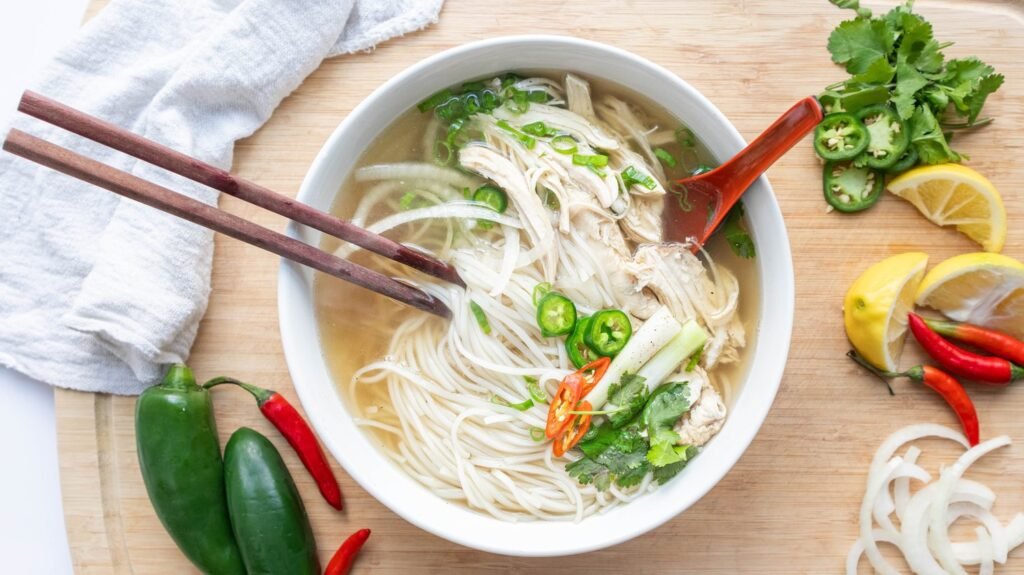Hello, readers! Are you looking to explore new culinary possibilities while maintaining a healthy and wholesome lifestyle? Look no further! In this blog post, I am excited to share with you some wonderful recipes that can be effortlessly created with a rice noodle maker. Whether you are a seasoned chef or an aspiring home cook, this post aims to cater to your needs by providing a range of delicious and nutritious options. So, let’s dive in together and uncover the vast world of healthy and flavorsome dishes that can be crafted with the help of a rice noodle maker.
How Rice Noodles Are Made
What is a Rice Noodle Maker?
Rice noodles are a popular staple in many Asian cuisines, such as Thai, Vietnamese, and Chinese. These delicate, translucent noodles are a versatile ingredient in various dishes, from stir-fries to soups. Traditionally, making rice noodles at home can be a time-consuming and labor-intensive process. However, with the help of a rice noodle maker, you can now easily create your own fresh rice noodles in the comfort of your own kitchen.
How Does a Rice Noodle Maker Work?
A rice noodle maker is a kitchen appliance designed specifically for making rice noodles. It consists of a main unit with various attachments that allow you to mix, knead, and extrude the rice noodle dough. Here’s a step-by-step guide to how it generally works:
- Preparing the dough: You start by preparing a rice batter, traditionally made from soaked rice that is then ground into a smooth paste. However, with some modern rice noodle makers, you can use rice flour mixed with water for convenience.
- Mixing the batter: The batter is poured into the main unit of the rice noodle maker and mixed thoroughly to ensure a consistent and smooth texture. Some models have built-in mixing functions, while others may require manual stirring.
- Kneading the dough: Once the batter is well-mixed, the rice noodle maker starts kneading the mixture, mimicking the traditional hand-kneading process. This step is crucial as it develops the elasticity and texture of the dough.
- Extrusion: After kneading, the dough is ready to be extruded into the desired noodle shape. The rice noodle maker typically comes with different attachments, allowing you to choose between flat, wide, or thin noodle shapes. You simply attach the desired die and let the appliance do the rest.
- Cooking: Once you have extruded the noodles, they can be immediately placed in boiling water or steamed to cook. The cooking time is usually brief, as rice noodles have a delicate texture and can become mushy if overcooked. After cooking, the fresh noodles are ready to be used in various dishes.
Features of a Rice Noodle Maker
Rice noodle makers often come with a range of features that enhance convenience and functionality. Here are some common features:
- Adjustable thickness: Many rice noodle makers allow you to adjust the thickness of the noodles, giving you control over the texture of your finished product.
- Multiple die choices: Different attachments offer a variety of noodle shapes, making it possible to create different types of rice noodles to suit your culinary preferences.
- Efficient motor: A powerful motor ensures smooth and consistent mixing, kneading, and extrusion of the dough.
- Easy cleanup: Removable parts and dishwasher-safe components simplify the cleaning process after use.
- Compact design: Rice noodle makers are often designed with space-saving considerations, making them suitable for small kitchens or limited countertop spaces.
Benefits of Using a Rice Noodle Maker
Investing in a rice noodle maker can offer several advantages:
- Time-saving: Making rice noodles from scratch by hand can be time-consuming, but with a rice noodle maker, you can produce fresh noodles in a fraction of the time.
- Consistent results: The automated process of a rice noodle maker ensures that each batch of noodles is uniform in texture and thickness, eliminating variations that might occur with manual methods.
- Customization: With different die options, you can experiment with various noodle shapes and sizes to suit different recipes or personal preferences.
- Versatility: A rice noodle maker is not limited to rice-based noodles. You can also use it to make other types of noodles, such as wheat or tapioca-based noodles.
- Cost-effective: Making your own rice noodles at home can be more cost-effective than buying pre-packaged noodles, particularly if you frequently use them in your cooking.
Preparing Rice Noodles with a Rice Noodle Maker
Rice noodles are a popular staple in many Asian cuisines and can be enjoyed in various dishes such as stir-fries, soups, and salads. While you can find pre-packaged rice noodles in stores, there’s nothing quite like making your own fresh noodles at home. In this blog section, we will guide you through the process of preparing rice noodles using a rice noodle maker.
Ingredients needed:
- Rice flour
- Water
Step-by-step instructions:
Step 1: Mix the Rice Flour and Water
- In a mixing bowl, combine the rice flour and water. The ratio of rice flour to water is typically 1:1, but it may vary depending on the specific brand of rice flour you are using. Follow the instructions on the packaging for the best results.
Step 2: Heat the Mixture
- Pour the rice flour and water mixture into a saucepan and heat it over low heat. Continuously stir the mixture until it thickens into a smooth batter-like consistency. This process helps to activate the starch in the rice flour and ensures that the noodles will hold their shape when cooked.
Step 3: Prepare the Rice Noodle Maker
- While the mixture is still warm, transfer it into a rice noodle maker. Make sure to follow the manufacturer’s instructions for assembling and operating the machine. Most rice noodle makers consist of a container to hold the batter and a set of steamers.
Step 4: Steam the Noodles
- Once the rice noodle maker is ready, place it in a steamer or on a pot with water boiling beneath it. Close the lid tightly, ensuring that the steam does not escape during the cooking process. The steam will cook the batter and transform it into delicate rice noodles.
Step 5: Cool and Cut the Noodles
- After approximately 5-10 minutes of steaming, remove the rice noodle maker from the heat and let it cool for a few minutes. Carefully remove the lid and gently peel the cooked rice noodles away from the surface of the steamer container. Cut the noodles into desired lengths using a sharp knife or kitchen shears.
Benefits of Using a Rice Noodle Maker:
- Consistent thickness and texture of the noodles.
- Faster and more efficient process compared to hand-cutting noodles.
- Convenient for making a large batch of noodles.
- Easy to clean and maintain.
- Versatile, allowing you to experiment with various flavors and ingredients.
As you can see, making your own rice noodles using a rice noodle maker is a straightforward process that yields delicious and fresh noodles. By following these step-by-step instructions, you can enjoy homemade rice noodles in your favorite dishes whenever you desire. So why settle for store-bought noodles when you can have the satisfaction of creating your own? Experience the joy of homemade rice noodles by investing in a rice noodle maker today!
Remember to always refer to the specific instructions provided by your rice noodle maker’s manufacturer for the best results. Enjoy your homemade rice noodles!
Healthy and Delicious Rice Noodle Recipes
Rice noodles are a versatile and gluten-free option that can be enjoyed by people with various dietary preferences. In this blog section, we will explore a range of healthy and delicious recipes that can be easily prepared using a rice noodle maker. Whether you’re a vegetarian or a non-vegetarian, these recipes are sure to satisfy your taste buds while keeping you on track with your health goals.
Vegetarian Rice Noodle Recipes
1. Vegetable Stir-Fried Rice Noodles
- Sautee a colorful assortment of vegetables such as bell peppers, broccoli, and carrots.
- Toss in cooked rice noodles and season with soy sauce, garlic, and ginger.
- Add a dash of lime juice for a refreshing twist.
- Enjoy a nutritious and flavorful vegetarian meal!
2. Spicy Thai-Style Curry Noodles
- Prepare a fragrant paste by blending together red curry paste, coconut milk, and spices like lemongrass and coriander.
- Cook rice noodles separately and drain.
- In a pan, combine the curry paste with vegetables like snow peas, bell peppers, and tofu.
- Add the cooked rice noodles to the pan and mix well.
- Garnish with fresh cilantro and chopped peanuts for added texture and taste.
3. Zesty Lemon and Herb Noodle Salad
- Boil rice noodles until tender and rinse with cold water.
- Toss the noodles with thinly sliced cucumbers, cherry tomatoes, and a handful of fresh herbs like mint and basil.
- Dress the salad with a zesty mixture of lemon juice, olive oil, and a pinch of salt.
- Serve chilled for a refreshing and healthy lunch option.
Non-Vegetarian Rice Noodle Recipes
1. Shrimp and Garlic Rice Noodles
- Sautee shrimp and minced garlic in a pan until the shrimp turns pink.
- Prepare the rice noodles separately and drain.
- Toss the cooked noodles with the shrimp and garlic mixture.
- Drizzle with a soy sauce and sesame oil dressing for added depth of flavor.
- Top with sliced scallions and sesame seeds for a restaurant-quality dish.
2. Beef and Broccoli Rice Noodles
- Marinate thinly sliced beef in soy sauce, ginger, and garlic for 15 minutes.
- Stir-fry the marinated beef with broccoli florets and thinly sliced onions.
- Cook the rice noodles separately and drain.
- Toss the noodles with the beef and broccoli stir-fry, adding a bit more soy sauce if desired.
- Sprinkle with sesame seeds and serve for a hearty and satisfying meal.
Benefits of Rice Noodles
- Gluten-free alternative to wheat-based noodles.
- Low in calories and fat, making it a great option for weight management.
- Contains essential nutrients like iron and B vitamins.
- Versatile and can be used in a variety of dishes from stir-fries to salads.
- Quick and easy to prepare, making it a convenient choice for busy individuals.
In conclusion, rice noodles are a healthy and delicious option for anyone looking to diversify their diet or accommodate dietary preferences. Whether you prefer vegetarian or non-vegetarian options, these recipes are sure to impress. Try them out and enjoy the delectable taste of rice noodles combined with a medley of flavors and ingredients.
Tips and Tricks for Using a Rice Noodle Maker
Using a rice noodle maker can be a game-changer in your kitchen, allowing you to effortlessly create fresh and delicious homemade rice noodles. To help you make the most of this handy kitchen appliance, we’ve compiled a list of tips and tricks to ensure your success. Whether you’re a novice or seasoned cook, these suggestions will help you achieve perfect results every time.
1. Select the Right Rice Flour
Choosing the right rice flour is crucial to the success of your rice noodle-making venture. Opt for a high-quality rice flour specifically labeled for making rice noodles. Avoid using glutinous rice flour, as it will result in sticky noodles that lack the desired texture.
2. Perfect Ratios and Consistency
Achieving the perfect consistency of your rice noodle batter is essential. Follow the recommended ratio of rice flour to water mentioned in the manufacturer’s instructions. Generally, a ratio of 1:1 or 1:1.5 (rice flour to water) works well. Adjust the amount of water as needed to achieve a smooth and flowing batter consistency that resembles pancake batter or heavy cream.
3. Prepping the Rice Noodle Batter
Preparing the rice noodle batter correctly is crucial for optimal results. Here are some key steps to follow:
- Sift the Rice Flour: Sifting the rice flour before mixing helps remove any lumps and ensures a smooth batter.
- Let the Batter Rest: Allow the batter to rest for at least 30 minutes before using it. This resting period allows the rice flour to fully absorb the water, resulting in smoother and more elastic noodles.
4. Avoiding Stickiness
Sticking rice noodles can be a challenge, but with the right techniques, you can overcome this hurdle. Here are some strategies to prevent your noodles from sticking:
- Use a Non-Stick Surface: Spray the surface of the noodle maker with a non-stick cooking spray before pouring the batter. This will help prevent the noodles from sticking during the cooking process.
- Work Quickly: Once the noodles are cooked, remove them from the noodle maker promptly. Leaving them in the maker for too long can cause them to stick together.
5. Play with Flavors and Ingredients
Don’t be afraid to experiment with different flavors and ingredients to elevate your rice noodle game. Here are a few ideas to get you started:
- Add Natural Colorings: For visually appealing noodles, consider adding natural colorings such as beet juice, spinach puree, or carrot juice to the batter.
- Incorporate Herbs and Spices: Mix fresh herbs or spices into the batter for a burst of flavor. Cilantro, basil, turmeric, or even chili powder can add an interesting twist to your noodles.
With these tips and tricks in mind, you’re well-equipped to make the most out of your rice noodle maker. Explore different recipes, get creative, and enjoy the satisfaction of preparing mouthwatering rice noodles at home.
Remember, practice makes perfect, so don’t be discouraged if your first attempt doesn’t turn out exactly as planned. Adjustments may need to be made to suit your specific rice noodle maker and personal preferences. Happy noodle-making!

Closing Thoughts: Exploring the Culinary Possibilities of Rice Noodle Making
In conclusion, a rice noodle maker is a fantastic addition to any kitchen, providing a convenient way to make homemade rice noodles. By utilizing the recipes and guidance offered in this blog post, you can effortlessly prepare mouthwatering and nutritious meals in the comfort of your own home. I strongly recommend considering a rice noodle maker for anyone who appreciates Asian cuisine and desires to infuse their dishes with a personalized touch.
Read More :














